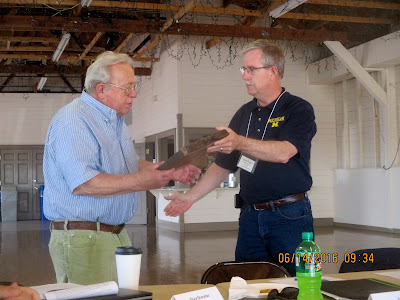 |
| LUPINES ARE DONE BLOOMING... |
 |
| ...WHITE DAISIES HAVE REPLACED THEM... |
 |
| ...ALONG WITH COREOPSIS... |
 |
| ...AND ORANGE HAWKWEED |
Thursday, 8:00 AM. 61 degrees F at the ferry dock, 58 on the back porch. Wind variable and calm, the sky overcast with occasional rain, and leaving a trace thereof. The humidity is 92%, the barometer more or less steady, now at 29.91". It looks like it will be a quiet, damp morning but the holiday weekend should be sunny with moderate temperatures.
The cool, rainy spring has given us a full month of Lupine bloom, but the glorious display is now ending, to be replaced in fields and along roadsides with wildflowers and weeds that are every bit as colorful. I have already mentioned sweet Cicely, but the common white daisy, Chrysanthemum leucanthemum, a European import in the Aster Family, now cheers the fields. It is joined by the native yellow Coreopsis lanceolata, also in the Aster Family. The common name of Coreopsis is tictickseed, which relates to the seed, that is a familiar "stick tight," clinging to clothing and long haired hunting dogs. Coreopsis is translated from the classical Greek, and means "bug-like"; the species name is from the Latin, and describes the leaves.
Lupinus is from the Latin for wolf, the genus so named because it was once thought that it "wolfed" the nutrients of the soil and made it poor for crops. In actuality the plants fix nitrogen and enrich the soil, but since they grow abundantly on poor, sandy soil they were thought to be the cause, rather than the effect.
Orange hawkweed, Hieracium aurantiacum, in the Aster Family as well, grows among the daisies and other plants, its orange flowers a pleasing contrast. The genus name refers to the Latin for hawk, and the species name is Latin for orange-red. It is more prevalent northward in Wisconsin than in the south.
An etymological aside: in the 18th Century, when Linaeus and others were establishing the binomial system of classification of living things, many classical Greek words were adopted into the then modern Latin, which was then thought would become the universal language of science. It did attain that goal in many respects.
Lupinus is from the Latin for wolf, the genus so named because it was once thought that it "wolfed" the nutrients of the soil and made it poor for crops. In actuality the plants fix nitrogen and enrich the soil, but since they grow abundantly on poor, sandy soil they were thought to be the cause, rather than the effect.
Orange hawkweed, Hieracium aurantiacum, in the Aster Family as well, grows among the daisies and other plants, its orange flowers a pleasing contrast. The genus name refers to the Latin for hawk, and the species name is Latin for orange-red. It is more prevalent northward in Wisconsin than in the south.
An etymological aside: in the 18th Century, when Linaeus and others were establishing the binomial system of classification of living things, many classical Greek words were adopted into the then modern Latin, which was then thought would become the universal language of science. It did attain that goal in many respects.
























































